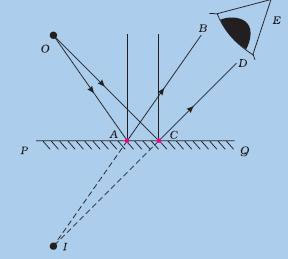Question: What do you understand by irregular reflection?
Answer: When the reflected rays are not parallel to each other; this case of reflection is called irregular reflection. Irregular reflection happens from a rough surface. The laws of reflection are obeyed in this case as well but because of the irregularities in the surface, the reflected rays are not parallel. We get to see somewhat blurred images when image is formed by irregular reflection. The relative clarity of an image depends on the relative smoothness of the reflecting surface.
Question: Write a short note on multiple reflections?
Answer: When two or more mirrors are placed at some angles to each other, we get to see multiple images. Let us take an example in which two mirrors are placed opposite to each other. If an object is placed between them, its image is formed in both the mirrors. The image in one mirror would act as an object for another mirror and this sequence would continue. This will result in the formation of multiple images.
Question: How will you trace image formation in plain mirror?
Answer: Image Formation in Plane Mirror

In the image above, PQ is a plain mirror and O is an object. OA and OC are the incident rays; coming from the object. The incident rays are reflected from the mirror and reflected rays emerge as AB and CD. If AB and CD are extended behind the mirror, they appear to meet at point ‘I’. This is the point where image is formed. Since the reflected rays do not actually meet at I, but only appear to do so, we say that a virtual image of the point O is formed at I.
 Class Notes NCERT Solutions for CBSE Students
Class Notes NCERT Solutions for CBSE Students


